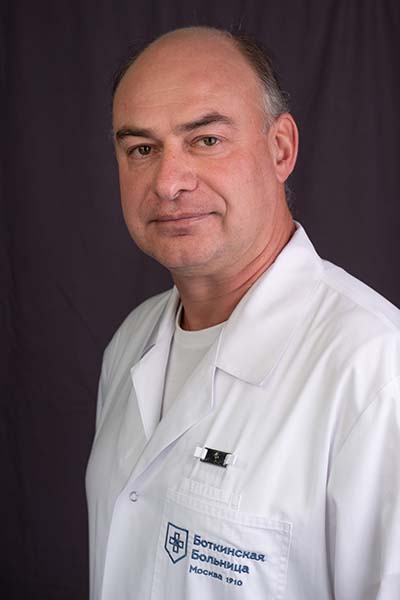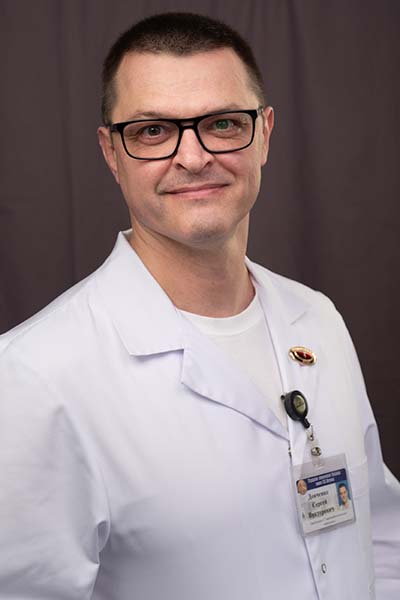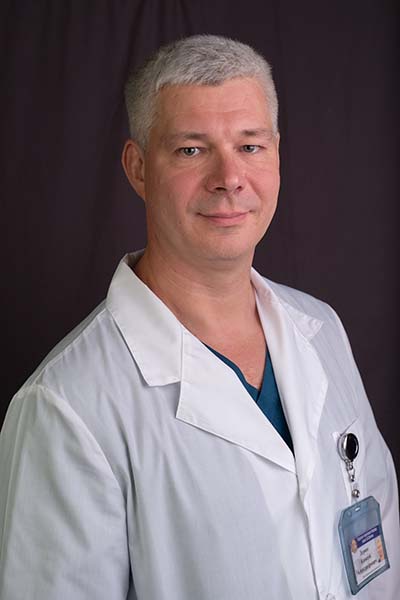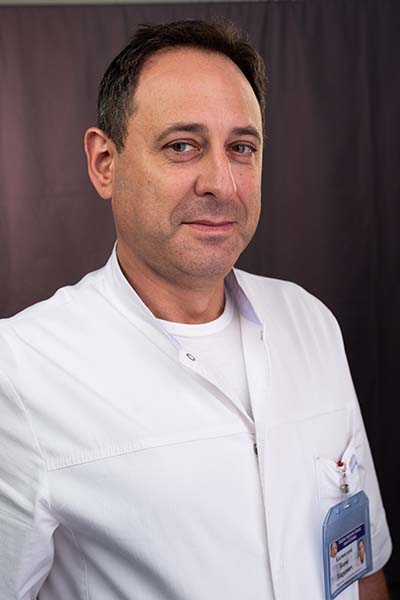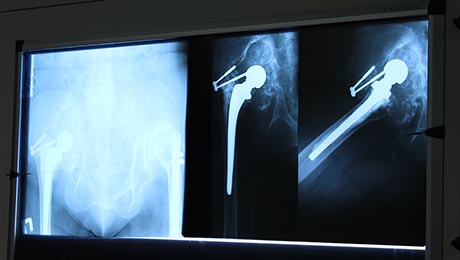
Department Of Traumatology #26
The Department Of Traumatology #26 is equipped with modern equipment for the treatment and primary rehabilitation of patients with diseases and injuries of the musculoskeletal system.
The Department employs 8 orthopaedic traumatologists, including 4 doctors of the highest qualification category, one doctor of the second category, as well as an older sister and 10 nurses. Specialists of the Department constantly improve their professional skills, participate in medical seminars, symposia, forums in Russia and abroad. Almost all employees have been trained at the courses of the International Association for the study of methods of internal fixation – AO/ASIF.
Doctors of the Department strive to find the most suitable surgical treatment for the patient, using knowledge and experience, using modern technology. The priority in the Department are minimally invasive and endoscopic methods. The examination of the patient uses almost the entire range of modern diagnostic procedures: classical radiography, Laboratory diagnostics, computed tomography, magnetic resonance imaging, ultrasound of muscles and joints, electromyography, plantography.
Doctors of the Department conducted a wide range of surgical interventions:
- Arthroscopic operations on knee, shoulder, elbow and ankle joints, including arthroscopic stabilization of knee and shoulder joints;
- Knee and hip replacement;
- Corrective surgery on bones and joints;
- Working with combined flat feet;
- Osteosynthesis of all long tubular bones of varying degrees of complexity;
- Operations with the consequences of injuries (false joints, incorrectly healed fractures, etc.) use of modern bone implants for replacement;
- Operation to restore soft tissue functions (reconstructive operations on the ligaments of the joints, reconstructive operations on skeletal muscles).

Department Of Traumatology #27
The Department Of Traumatology #27 performs the most modern types of treatment of patients with injuries and diseases of the musculoskeletal system:
- In case of pelvic bone fractures, all types of reconstructive operations are carried out;
- A unique technique of minimally invasive stabilization of the pelvic ring using the lumbar-pelvic system, reconstructive pelvic plates and cannulated screws was introduced;
- Osteosynthesis is carried out in multi-grained fractures of long tubular bones using navigation;
- Technologies of consecutive or simultaneous osteosynthesis by two or three surgical teams for patients with severe multiple and combined trauma have been developed;
- Minimally invasive vertebral-pelvic transpedicular fixation;
- Arthroscopic chondroplasty of knee and ankle joints using collagen membranes and mesenchymal cells;
- Combination of arthroscopy and chondroplasty with corrective tibial osteotomies;
- Arthroscopically, an operation is performed to restore the acromioclavicular joint.
Minimally invasive surgery using modern implants (pins, plates) with angular stability allows to perform operations with minimal blood loss, minimal tissue injury.
Scientific curator of the Department Slinyakov Leonid Yuryevich, doctor of medical Sciences, Professor of the Department of traumatology and orthopedics of the First MSMU n.a.I. M. Sechenov.
Employees of the Department annually undergo training in leading foreign clinics in Europe, are active participants of scientific conferences. Over the past 5 years, more than 50 articles have been published, 4 patents of the Russian Federation for inventions, including 1 patent for a method of treatment.
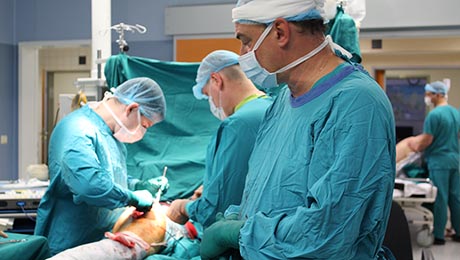
Department Of Orthopaedic #51
The orthopedic department treats injuries and diseases of the knee, shoulder and ankle joints, diseases of the foot and spine using modern high-tech, innovative surgical and conservative methods, including arthroscopy, arthroplasty of large joints and computer navigation.
The department has 4 doctors, three of whom are candidates of medical sciences. All doctors have a first or highest category. Of the 12 nurses, 4 have the highest category, 8 the first. Doctors and nurses of the department regularly improve their professional level, attend seminars, clinical conferences and continuing education courses.
Most often, patients treat the following diseases:
Hip joint
- Osteoarthrosis of various etiologies;
- Aseptic necrosis of the femoral head;
- Post-traumatic deformities of the hip joint, including after a previous operation.
Knee-joint
- Osteoarthrosis of various etiologies;
- Treatment of damage to the anterior cruciate ligament (fresh and old tears, revision arthroscopic operations after unsuccessful previous attempts, combined injuries);
- Post-traumatic deformities of the knee joint, including after previous surgical interventions;
- Treatment of meniscus lesions;
- Treatment of injuries of the posterior cruciate ligament;
- Treatment of damage to the lateral (collateral) ligaments;
- Treatment of deforming arthrosis of the knee joint (link to "Arthrosis of arthrosis");
- Treatment of patellar dislocation and lateral position of the patella (arthroscopic lateralization, thermal modification of medial sections, Yamamoto suture, MPFL plastic);
- Treatment of chronic and recurrent synovitis (synovectomy, coablation, biopsy).
Shoulder joint
- Acute and periodic dislocation of the shoulder;
- Rotator cuff ruptures;
- Rotator Cuff Collision Syndrome;
- Calcifying tendonitis;
- Adhesive capsulitis;
- Deforming osteoarthrosis.
Ankle joint
- Front impact syndrome;
- Post-traumatic injuries of the ankle joint;
- Deforming osteoarthrosis;
- Arthroscopic arthrodesis of the ankle joint.
Foot
- Arthroscopic treatment of heel spurs;
- Static deformations of the feet. Combined flat feet. Hallux valgus deformity of 1 toe (Hallux valgus, Hallux Valgus deviation of the first toe, “hit”). Varus deformity of the first metatarsal bone (metatarsus primus) with an increase in the angle of the forearm;
- Hammer-like deformation of the toes;
- Rigid first toe (Hallux hardus, hallux limitus) - severe pain and a decrease in the amplitude of the first toe moving in the metatarsophalangeal joint;
- Metatarsalgia - pain in the forefoot (painful "corns" on the plantar surface of the feet);
- Morton's neuroma (interdental neuroma, interdigital neuroma, Morton's disease);
- Deforming arthrosis of the metatarsophalangeal joints of the feet;
- Freiberg's disease (Freiberg's disease, osteochondropathy of the heads of the metatarsal bone - Keller II disease);
- Haglund's disease (osteochondropathy of the calcaneal region of the tuber, Schnitz-Haglund disease);
- Tarsal tunnel syndrome;
- Deforming osteoarthritis of the ankle joint with pain and a decrease in the amplitude of motion in the joints;
- Post-traumatic ankle deformities;
- Polydactyly, sock syndactyly;
- Damage and consequences of the muscles of the leg and foot (tendon of the posterior tibial muscle, etc.);
- Plantar fasciitis (calcaneal spur), not amenable to conservative treatment;
- Post-traumatic foot deformities;
- Flat valgus deformities of the feet. Equinus deformities of the feet;
- Hallux varus (varus deformity of the first finger) - subsequent injuries, congenital malformations and aggressive surgical interventions;
- Complex deformities, including unsatisfactory results of previous surgical interventions.

City Center For Bone And Joint Replacement
The profile of the Center is the treatment of patients with diseases and injuries of the joints of the upper and lower extremities, periprosthetic fractures.
Currently, the Moscow City Center For Bone And Joint Replacement annually produces more than 1 thowsend hip replacements, about 700 knee replacement operations. To date, the most complex high-tech operations for revision hip and knee arthroplasty have become routine for the Center, whereas in the early 2000s they were performed no more than 5 – 7 times a year.
Operations performed in the center of endoprosthetics:
- Total hip replacement using the most modern coatings and implant designs, the most wear-resistant pairs of friction;
- Unipolar hip replacement (in elderly patients with hip fractures);
- Full knee replacement, including the normal use of the computer navigation;
- Full shoulder replacement;
- Organ-preserving operations on the joints of the upper and lower extremities;
- Revision of hip replacement;
- Revision knee replacement;
- Osteosynthesis of periprosthetic fractures of the femur, tibia and humerus, pelvis.






